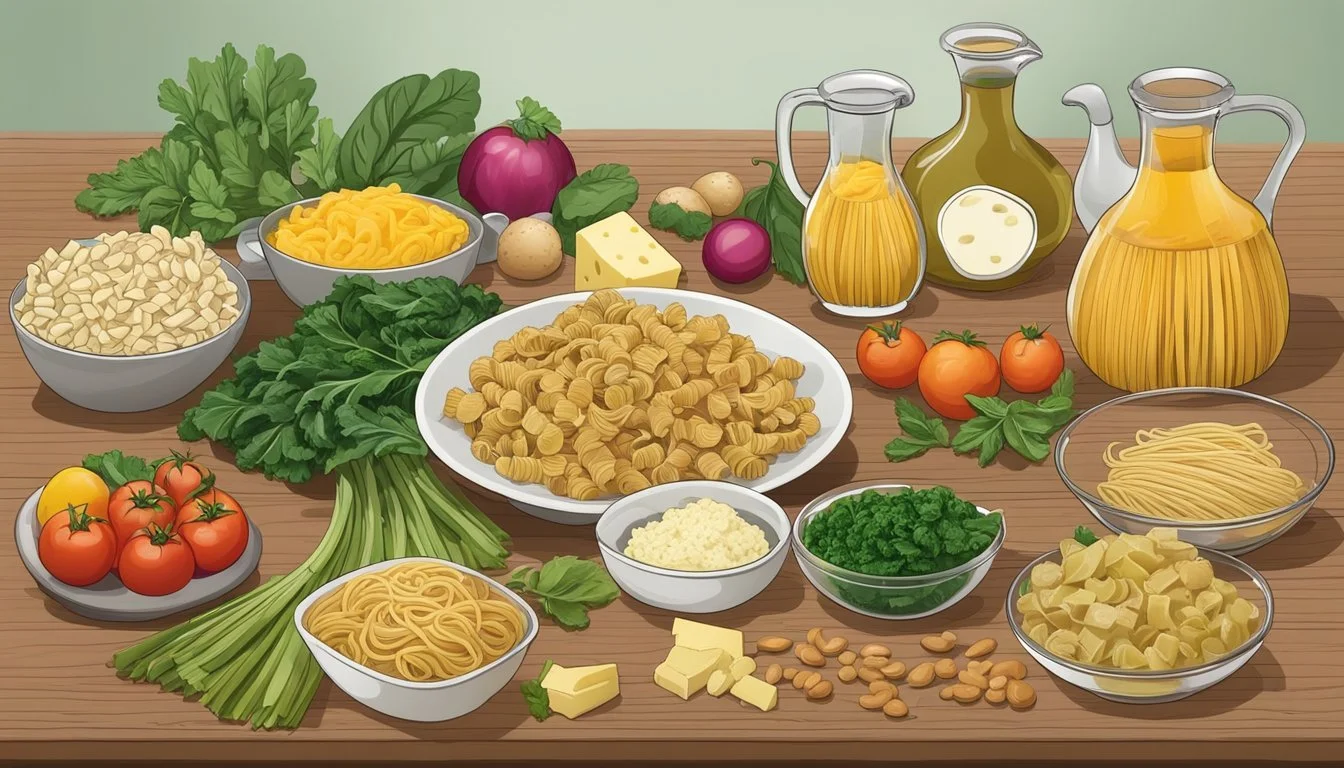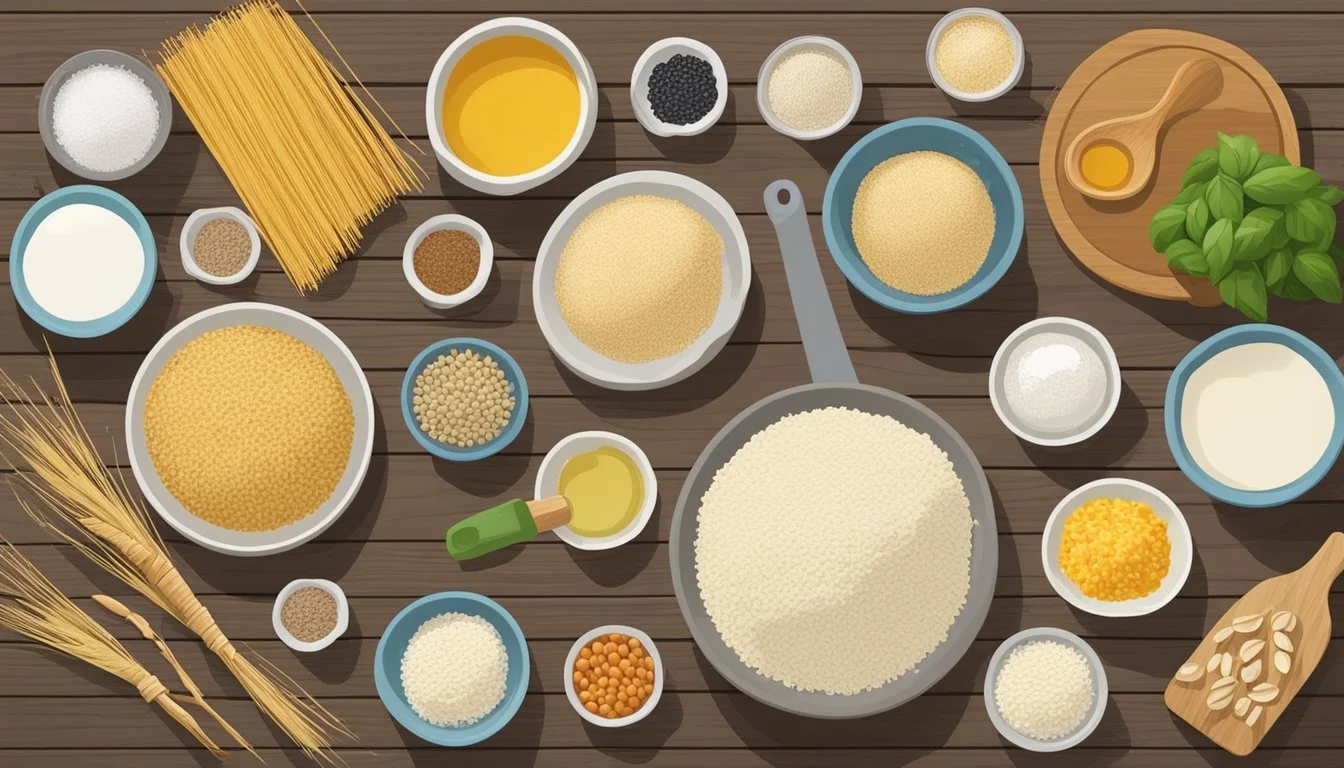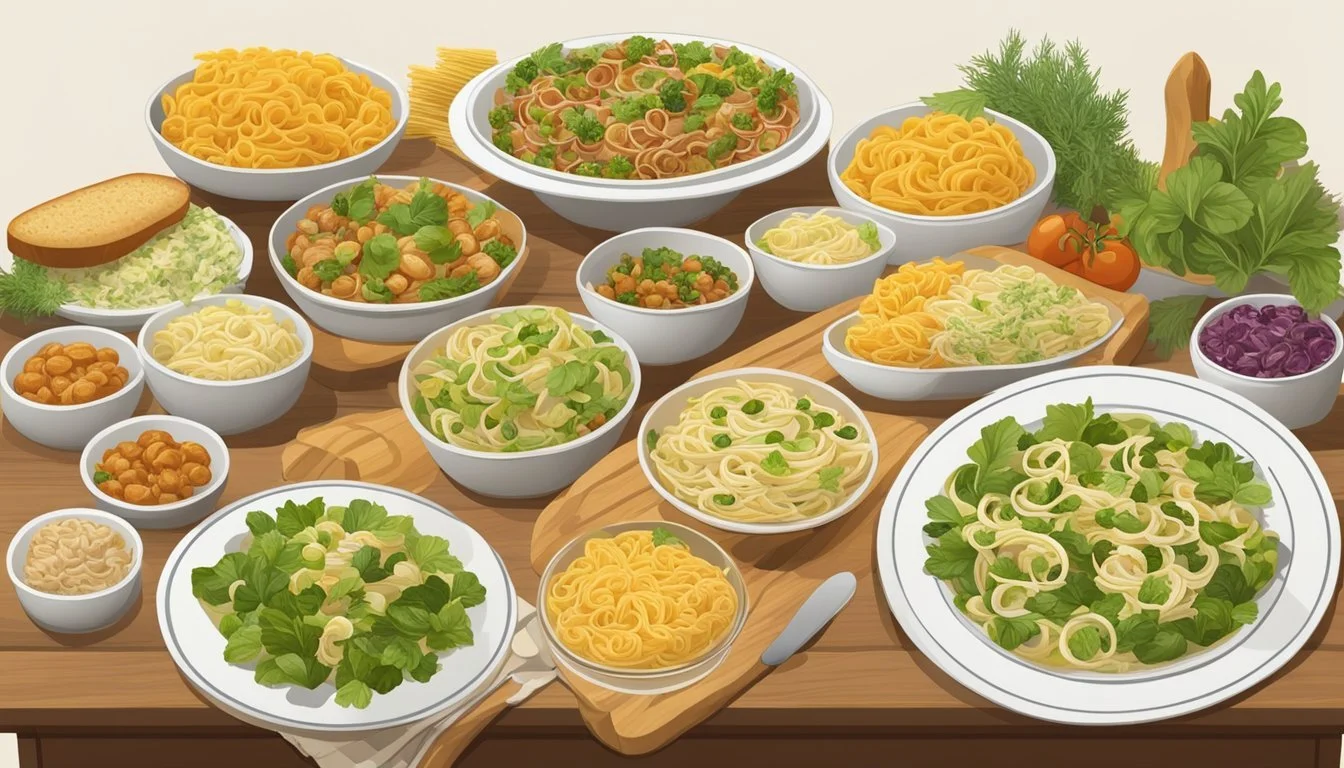Pizzoccheri Pasta Substitutes
Top Alternatives for This Traditional Dish
Pizzoccheri pasta (What wine goes well with pasta?), a traditional dish from the Valtellina region in northern Italy, is distinguished by its main ingredient: buckwheat flour. The pasta's earthy flavor and hearty texture make it a unique culinary experience that is deeply embedded in the local culture of the Lombardy region. However, it is not always easy to find outside of its native area, leading cooks to seek out suitable substitutes that can mimic the distinctive qualities of pizzoccheri.
Buckwheat, a pseudocereal, gives pizzoccheri its distinct grayish color and rich, nutty taste. This robust pasta is typically paired with ingredients like cabbage, potatoes, and melted cheese, creating a comforting and satisfying dish. Those looking to recreate the essence of pizzoccheri without the original pasta can consider various alternatives that complement the traditional accompaniments. Substitutes must be selected carefully to ensure they can withstand the bold flavors and maintain a similar texture to the original pizzoccheri.
Choosing an alternative to pizzoccheri pasta involves considering not just the flavor but also the pasta's ability to hold up under the weight of dense sauces and ingredients. Whole grain pastas, like whole wheat or spelt noodles, can offer a similar mouthfeel and taste profile, ensuring that the integrity of the dish is preserved. These substitutions honor the authenticity of the dish while making it accessible to those without access to traditional pizzoccheri pasta.
The Fundamentals of Pizzoccheri
Pizzoccheri is a traditional Italian pasta with a distinctive composition and cultural heritage, specifically from the Lombardy region. This section delves into what defines Pizzoccheri, its origins and significance, and the traditional ingredients used in its preparation.
Defining Pizzoccheri
Pizzoccheri is a type of pasta made predominantly from buckwheat flour, contributing to its unique, earthy taste and dark color. It is typically cut into short, ribbon-like shapes. The pasta is a staple in the alpine Lombardy region of Italy and is central to a dish known as Pizzoccheri alla Valtellinese.
Origin and Cultural Significance
Pizzoccheri hails from Valtellina, a valley in the Lombardy region of northern Italy. The pasta and its accompanying dish hold a cherished place in Italian culinary tradition, embodying the heartiness of mountain cuisine. Pizzoccheri della Valtellina carries a PGI status ("Protected Geographical Indication"), ensuring that its cultural authenticity is preserved.
Traditional Ingredients
The traditional Pizzoccheri dish, Pizzoccheri alla Valtellinese, brings together the robust flavors of the region. Key components include:
Buckwheat pasta: Pizzoccheri, the main ingredient.
Vegetables: Primarily savoy cabbage and potatoes.
Cheese: Valtellina Casera cheese, a semi-firm, cow's milk cheese, essential for its authentic flavor.
Seasoning: Aromatic garlic and sage are used to enhance the taste.
Butter: Used browned as a rich topping.
These elements combine to make Pizzoccheri not just food, but a reflection of the region's history, geography, and cultural identity.
Ingredients and Substitutes
When crafting a traditional Pizzoccheri dish, authenticity hinges on specific regional ingredients. Substitutes are chosen carefully to maintain the dish's integrity while allowing for dietary preferences or availability concerns.
Buckwheat Flour Alternatives
Pizzoccheri pasta's distinct flavor and texture are attributed to buckwheat flour. When unavailable, a suitable replacement is whole wheat flour, which preserves the pasta's hearty quality. For gluten-free diets, gluten-free flour blends can be used, offering a similar consistency.
Buckwheat Flour: Earthy, robust flavor.
Whole Wheat Flour: Nutty, dense alternative.
Gluten-Free Flour Blend: Varies, aim for one that mimics wheat's texture.
Replacing Traditional Cheese
The creaminess in Pizzoccheri typically comes from Taleggio cheese. To substitute, one can use Fontina or Brie, which melt well and offer a comparable taste and texture. For a non-dairy version, opt for cashew cheese mixed with nutritional yeast for a cheesy flavor.
Fontina/Brie: Creamy, melts smoothly.
Cashew Cheese: Non-dairy, enriched with nutritional yeast for flavor.
Vegetable Variants
Traditionally, Pizzoccheri includes potatoes and green vegetables like Swiss chard or green beans. They should be cut into even pieces to ensure uniform cooking. Alternate green vegetables such as spinach or kale can also be integrated into the dish.
Potatoes: Foundation of the dish, provide heartiness.
Swiss Chard/Green Beans: Slight bitterness, contributes to texture.
Spinach/Kale: Milder alternatives, easy to cook.
Meat Add-Ins and Alternatives
The dish can be enhanced with speck or pancetta for a smoky, meaty element. Those who abstain from pork can consider beef bresaola or smoked turkey. Vegetarian options include smoked tofu or tempeh, which impart a savory depth to the dish.
Speck/Pancetta: Traditional, smoky taste.
Beef Bresaola/Smoked Turkey: Non-pork meaty flavors.
Smoked Tofu/Tempeh: Vegetarian, imbues smokiness.
Cooking Techniques and Tips
In preparing Pizzoccheri, the cook’s expertise transforms simple ingredients into an enticing Italian dish. Details matter, from the pasta water's salinity to the final garnish touches, ensuring an authentic and delicious result.
Preparing Pizzoccheri Pasta
For the pasta, one should begin with plentiful boiling water, adding a generous amount of salt to achieve a sea-like salinity crucial for flavor. When cooking Pizzoccheri, timing is essential. The pasta should be boiled until it's just tender, which usually takes around 10 minutes. The delicate buckwheat pasta demands attention to avoid overcooking, which leads to mushiness.
Layering and Baking
The alchemy of butter and sage is critical in Pizzoccheri. To amplify the dish, one must heat butter until it froths, then infuse it with sage leaves to impart an aromatic depth. For those favoring the oven-baked variation, chefs recommend layering the pasta with their chosen ingredients in a casserole dish and baking until the flavors meld and the top is golden-brown—a process which typifies the most succulent traditional dishes.
Serving Suggestions and Garnishes
When serving, a drizzle of extra-virgin olive oil adds a note of freshness and a light peppery zing. Chefs generally advise completing the Pizzoccheri with a grind of fresh pepper to enhance the earthy flavors. To garnish, they may offer a spoonful of garlic butter for intensity or shaved cheese for a melt-in-your-mouth finish.
Each step in the preparation and serving of Pizzoccheri matters, contributing to a dish that is at once wholesome, comforting, and unmistakably Italian.
Popular Variations
Pizzoccheri, the traditional buckwheat pasta from the Valtellina region of Lombardy in Northern Italy, is renowned for its nutty flavor and heartiness. Diverse in application, this staple allows for numerous renditions, reflecting regional identities, dietary preferences, and contemporary tastes.
Regional Twists
Different areas in Northern Italy introduce local cheeses and ingredients to create unique twists on the classic Pizzoccheri alla Valtellina. Valtellina Casera DOP cheese is a traditional choice, but alternatives like Bitto, Montasio, and Gruyère may also find their way into the dish. Incorporating Fontina or Grana Padano offers a creamier or more grainy texture, respectively. Some regions might serve this pasta similarly to Tagliatelle, showcasing the versatility within Italian locales.
Vegetarian and Vegan Adaptations
Vegetarian versions of Pizzoccheri maintain the dish's hearty qualities by leveraging cheeses such as Parmesan or Fontina cheese, which can be substituted with plant-based alternatives for a vegan version. Going gluten-free is achievable by using alternative flours for the homemade Pizzoccheri, ensuring those with dietary restrictions can still relish in this Northern Italian comfort food.
Modern Takes on Pizzoccheri
Contemporary recipes might deemphasize the rustic roots of Pizzoccheri in favor of new, modern aesthetics and flavors. A drift away from Casera to more internationally recognized cheeses like Parmigiano Reggiano reflects a blend of tradition and trend. Incorporating ingredients like speck and zucchini or creating a sauce base with taleggio cheese and milk adds variety and caters to personal preferences without straying too far from the soul of the Teglio-originated pasta.
Nutritional Profile and Benefits
Pizzoccheri, the hearty buckwheat pasta from Italy, is not just a comforting meal but also brings a host of nutritional benefits, being rich in valuable nutrients that contribute to a healthy diet.
Health Impact of Ingredients
Buckwheat, the main component of pizzoccheri, is not a grain but a seed related to rhubarb and sorrel, making it a suitable choice for those sensitive to wheat or other grains. Buckwheat is high in antioxidants and polyphenols, which are nutrients that can support heart health. It's also a good source of protein and fiber. Moreover, buckwheat pasta can deliver nutrients such as magnesium, copper, and manganese — all vital for bodily functions.
Pizzoccheri is traditionally made with savoy cabbage and potatoes, adding vitamins and minerals to the dish. Savoy cabbage, a type of green cabbage, is known for its high vitamin K content, which is crucial for bone health, and is a great source of vitamin C, aiding the immune system.
Balancing the Diet with Pizzoccheri
Incorporating pizzoccheri into one's diet can offer a balance of macronutrients. The buckwheat pasta is a whole-food-based complex carbohydrate, making it a healthier alternative to refined pasta. It contributes to a steady energy release, unlike simple carbohydrates that can cause a spike in blood sugar levels.
Whole wheat alternatives can also be used in making pizzoccheri, offering additional fiber and keeping one sated longer. This is beneficial for those managing their weight or blood sugar levels. Including a portion of pizzoccheri provides a robust, nutrient-dense base for a meal, while also allowing for customization with a variety of healthy toppings, such as leafy greens and lean proteins, to round out the dish.
Preservation and Storage
Proper preservation and storage techniques ensure the longevity and quality of fresh Pizzoccheri pasta. These methods vary depending on whether the pasta is to be used immediately or kept for longer periods.
Best Practices for Fresh Pizzoccheri
Fresh Pizzoccheri should be stored in a cool and dry environment. If it is to be used within a day, the pasta can be covered with cling film and refrigerated. For best results, the pasta should be laid flat on a baking sheet and not stacked to prevent sticking. They may also be dusted with a little flour to maintain separation.
Freezing and Reheating Instructions
To freeze Pizzoccheri, one should first lay the pasta flat on a baking sheet and freeze until solid to prevent clumping. Once frozen, transfer the pasta into airtight bags or containers to avoid freezer burn. When ready to use, Pizzoccheri can be cooked directly from frozen, adding a few minutes to the usual cooking time from the recipe. Reheating should be done by boiling in salted water until tender, typically taking 10-12 minutes.
Preservation and proper storage are critical for maintaining the texture and taste of Pizzoccheri pasta, whether one intends to follow a traditional recipe or experiment with substitutes.
Related Dishes and Accompaniments
When exploring Pizzoccheri pasta, a dish deeply rooted in the Italian Alps, one discovers a wealth of hearty accompaniments and complementary dishes that highlight the robust flavors of northern Italian cuisine.
Complementary Italian Dishes
Pizzoccheri, known for its buckwheat pasta and cheese-heavy recipes, pairs well with other Italian Alpine dishes. Speck and zucchini can be sautéed and served alongside as a flavorful addition. Traditional Osso Buco, braised veal shanks in white wine and broth, offers a substantial protein that complements the rich taste of Pizzoccheri. Another typical dish that can be served in harmony is Polenta, often cooked with butter, cheese, and garlic cloves, providing a warming contrast to the earthiness of the buckwheat pasta.
Selecting a Wine Pairing
Matching wine with Pizzoccheri involves considering the full-bodied and hearty nature of the pasta. For red wine enthusiasts, a Barolo or Barbaresco can encapsulate the essence of the Italian Alps, providing a robust accompaniment. Conversely, a Gavi or Soave, with their lighter and crisp profiles, can balance the dish's richness when preferring white wines. Opt for wines that feature a high acidity to cut through the creamy textures.
Sides and Salads
Sides should not overpower the main course, but rather enhance its natural flavors. A simple salad of arugula and shaved Parmesan, dressed with extra-virgin olive oil and a splash of balsamic vinegar, offers a refreshing bite. For those seeking a heartier side, roasted vegetables such as onions and zucchini, drizzled with olive oil and seasoned with salt, excellently accompany the core ingredients of Pizzoccheri. Roasted pears can add a sweet dimension, particularly when they are poached in a reduction of the selected wine and served as a warming dessert.
By considering these related dishes and accompaniments, one can construct a balanced and regionally authentic meal that elevates the taste experience of Pizzoccheri.








